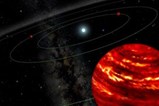First-Ever Images Of Another Solar System Captured By An International Team Of Astronomers


In an unprecedented discovery, a team of Canadian, American and British researchers have photographed a distant new planetary system as reported in the November 13 edition of Science Express. The three planets, photographed using Keck and Gemini North telescopes, are young enough to glow at infrared wavelengths resulting from heat generated during their formation.
The researchers developed a sophisticated image processing algorithm called angular differential imaging (AD), which helped reveal the presence of the three planets around the star HR8799 (Gemini Deep Planet Survey) located in the constellation Pegasus.
The mass of the star is about 1.5 times that of the Sun and its age is about 60 million years, significantly below that of the Sun. HR8799 is located 130 light years from the Sun and is barely visible with the naked eye outside major urban centres.
A professor from the Department of Physics of the Université de Montréal and two alumni were part of the discovery team: alumnus Christian Marois now of the Herzberg Institute of Astrophysics (Victoria, BC), alumnus David Lafrenière, now of the University of Toronto, and professor René Doyon, director of the Mont-Mégantic Observatory and member of the Centre de Recherche en Astrophysique du Québec (CRAQ).
Christian Marois says this is the first time that a scientific team secured images of several planets around a star outside our solar system. He adds the discovery is a crucial step towards finding a planet resembling Earth: "All major telescopes around the world will now be pointed towards this star to learn more about this fascinating new solar system." said co-author René Doyon.
A previous survey — the GPDS (Gemini Deep Planet Survey) — on the Gemini North telescope, codirected by René Doyon and David Lafrenière between 2004 and 2007, showed that giant planets such as Jupiter are relatively rare around young stars with orbital separations on the scale of our solar system. "Using the ADI technique, we searched around 85 young stars of mass no greater than the Sun, and no planets were found. The next step was to search around a larger number of stars and especially those more massive than the Sun. This system is a gift from Nature. It's incredible that our first detection found not one, not two, but three planets around the same star," says Doyon.
The observations of HR8799 are part of a larger-scale survey — IDPS (International Deep Planet Survey) — of 80 relatively young, massive stars, surrounded by a dust disk and located in the solar neighbourhood. The survey uses the 10m and 8m Keck and Gemini North telescopes (both located in Hawaii) and one of the four 8m ESO VLTs (Very Large Telescope – ESO = European Southern Observatory) in order to obtain images of giant planets that resemble Jupiter.
First author Christian Marois notes that this first detection occurred after only a few stars had been surveyed. This may suggest such systems are more common around massive stars than previously believed. "Our on-going survey (IDPS) will answer this question," said Dr. Doyon.
SOURCE: Université de Montréal
